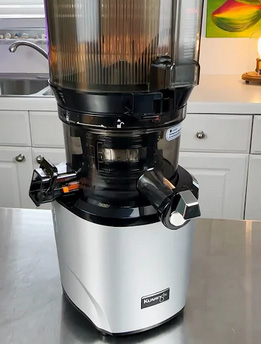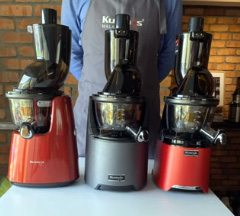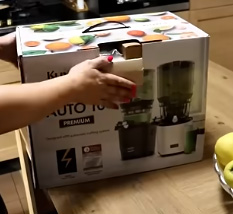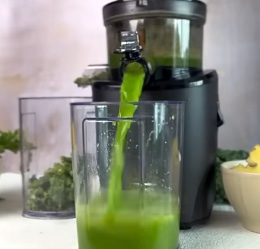I’m no stranger to the world of juicing. Over the years, I’ve churned through countless fruits and veggies, chasing that perfect glass of nutrient-packed goodness. When I decided to upgrade my juicer, I found myself torn between two heavyweights from Kuvings: the REVO830 and the AUTO10. Both are top-tier cold press juicers, but they cater to slightly different needs. In this article, I’ll walk you through my experience comparing these machines, breaking down their pros, cons, and key features to help you decide which one fits your kitchen and lifestyle.
Comparison Table: Kuvings REVO830 Vs. AUTO10
| Feature | Kuvings REVO830 | Kuvings AUTO10 |
| Juice Yield | High (e.g., 402 ml from 500 g celery) | Slightly lower (e.g., 350 ml from 500 g celery) |
| Feed Chute | 3.5-inch flip gate + 1.7-inch Auto-Cut chute | 100 oz (3L) auto-feeding hopper |
| Juicing Style | Manual feeding, ingredient control | Hands-free, batch juicing |
| Pulp Outlet | Wider, fixed outlet | Hinged, larger, less clog-prone |
| Run Time | Up to 60 minutes | Up to 45 minutes |
| Warranty | 15 years | 15 years |
| Attachments | Smoothie, sorbet, citrus (optional) | Smoothie, sorbet, citrus (optional) |
| Cleaning | Easy, wider outlets | Easier, fewer parts, hinged pulp chute |
| Price (SGD) | ~$1,288 | ~$1,388 |
| Best For | Precision juicing, fibrous ingredients | Batch juicing, convenience |
My Journey With Juicing
Read More: My Thought on Hurom H200 Vs. Hurom H400

I’ve been juicing for years, ever since I realized store-bought juices just weren’t cutting it. There’s something satisfying about tossing fresh produce into a machine and watching vibrant liquid pour out, packed with vitamins. My old juicer, a clunky centrifugal model, was loud and left wet pulp, wasting half the goodness. When I heard about Kuvings’ slow juicers, I knew it was time for an upgrade. The REVO830 and AUTO10 caught my eye for their innovative designs, but choosing between them wasn’t easy. I spent weeks testing both, and here’s what I learned.
Understanding Kuvings’ Cold Press Technology
Kuvings has been a trusted name in juicing for over 40 years, and both the REVO830 and AUTO10 use their signature cold press technology. This means they operate at low speeds (40-50 RPM) to gently extract juice without generating heat, preserving nutrients and enzymes. Unlike my old centrifugal juicer, which spun at high speeds and oxidized the juice, these machines produce clear, smooth juice with minimal foam. Both models can handle fruits, veggies, leafy greens, and even make nut milks and sorbets with optional attachments. But their approaches to juicing differ significantly.
Kuvings Revo830: The Precision Juicer
The REVO830 feels like the Swiss Army knife of juicers. It’s designed for those who love control over their juicing process. The standout feature is its dual feed chute system: a 3.5-inch flip gate for whole fruits like apples and beets, and a 1.7-inch Auto-Cut chute tailored for long, fibrous ingredients like celery and carrots. The Auto-Cut chute has a bladeless chopping mechanism that slices these ingredients as they feed, reducing clogs and making prep a breeze.
I tested the REVO830 with a mix of apples, carrots, and celery. The Auto-Cut chute handled celery like a champ—no stringy fibers wrapping around the auger, which was a problem with my old juicer. The 3.5-inch chute let me toss in whole apples without chopping, saving time. The juice was clear, with minimal pulp, and the pulp itself was impressively dry, indicating high yield. In a test with 500 grams of celery, I got 402 ml of juice, one of the highest yields among vertical juicers I’ve tried.
The REVO830’s auger is another highlight. It’s equipped with a chopping mechanism that breaks down fibrous ingredients before juicing, ensuring smooth operation. The machine runs for up to 60 minutes without overheating, which is great for longer sessions. Its wider pulp and juice spouts make cleaning easier than older models like the EVO820, and the included cleaning tools are a nice touch. The REVO830 also comes with a 15-year warranty, giving me peace of mind for long-term use.
Pros Of The REVO830

- High Juice Yield: Extracts more juice (e.g., 402 ml from 500 g celery) than many competitors, including the AUTO10.
- Dual Feed Chutes: The 3.5-inch flip gate and 1.7-inch Auto-Cut chute offer flexibility for whole fruits and fibrous veggies.
- Fibrous Ingredient Handling: The chopping mechanism minimizes clogs with celery and carrots.
- Long Run Time: Up to 60 minutes, ideal for extended juicing sessions.
- Versatile Attachments: Optional smoothie, sorbet, and citrus attachments expand its functionality.
- Sleek Design: Compact and classy, it fits well in small kitchens.
Cons Of The REVO830
- Manual Feeding: You need to add ingredients one at a time, which can be time-consuming for large batches.
- Fixed Pulp Outlet: While wider than older models, it’s less convenient to clean than the AUTO10’s hinged chute.
- Price: At around $1,288 SGD, it’s a significant investment, though slightly cheaper than the AUTO10.
- Learning Curve: The dual chutes take some getting used to, especially for beginners.
Kuvings Auto10: The Hands-Free Hero
The AUTO10 is a game-changer for anyone who values convenience. Its defining feature is the massive 100 oz (3L) auto-feeding hopper, the largest in the vertical juicer market. You load it with ingredients, close the lid, and walk away while it juices. This hands-free approach is perfect for multitasking—I’d toss in a mix of apples, ginger, and greens, then prep dinner while the machine did its thing.
In my tests, the AUTO10 produced 350 ml of juice from 500 g of celery—slightly less than the REVO830 but still impressive. The juice quality was excellent, with a clear, smooth consistency thanks to Kuvings’ Max Filter Technology, which prevents micro-particles from sneaking into the juice. The AUTO10’s redesigned, hinged pulp outlet is a standout. It’s larger and less prone to clogging, especially with fibrous ingredients like ginger and turmeric. Cleaning is a breeze—fewer parts and a hinged chute mean less scrubbing.
The AUTO10 runs for up to 45 minutes, shorter than the REVO830, but sufficient for most home juicing needs. Like the REVO830, it comes with a 15-year warranty and optional attachments for smoothies, sorbets, and citrus. However, its larger size makes it bulkier, and I struggled to find cabinet space for it. The hopper’s size is a double-edged sword: it’s great for batch juicing but requires more prep cutting to fit ingredients properly.
Pros Of The AUTO10

- Hands-Free Juicing: The 100 oz hopper allows you to load ingredients and walk away, perfect for batch juicing.
- Easy Cleaning: Fewer parts and a hinged pulp outlet make cleanup quick and painless.
- Large Hopper: 30% larger than competitors like the Nama J2, ideal for juicing in bulk.
- Clog Resistance: The redesigned pulp outlet handles fibrous ingredients with less clogging.
- Versatile: Can handle fruits, veggies, leafy greens, nut milks, and sorbets with optional attachments.
- Quiet Operation: Surprisingly quiet, even with tough ingredients like beets.
Cons Of The AUTO10
- Lower Juice Yield: Slightly less efficient than the REVO830 (e.g., 350 ml vs. 402 ml from 500 g celery).
- Bulky Size: Takes up more counter and storage space, a challenge for small kitchens.
- Shorter Run Time: Limited to 45 minutes, less ideal for extended juicing.
- Price: At ~$1,388 SGD, it’s pricier than the REVO830.
- Prep Cutting: Ingredients need to be cut smaller to fit the hopper efficiently.
Head-To-Head Comparison
Read More: My Thought on Hurom H200 Vs. Hurom H400
Juice Yield and Quality
The REVO830 edges out the AUTO10 in juice yield. In my celery test, the REVO830 extracted 402 ml from 500 g, while the AUTO10 managed 350 ml. This difference, though small, adds up over time, especially if you juice daily. Both produce clear, pulp-free juice, but the REVO830’s auger and dual chute system give it a slight advantage for fibrous ingredients, resulting in drier pulp and less foam.
Ease of Use
The AUTO10 wins hands-down for convenience. Its auto-feeding hopper lets you load everything at once, making it ideal for busy mornings or batch juicing. I loved being able to prep ingredients, start the machine, and focus on other tasks. The REVO830, while efficient, requires you to feed ingredients gradually, which can feel tedious for large batches. However, the REVO830’s dual chutes offer more control, letting you adjust the order and pace of juicing.
Cleaning and Maintenance
Both juicers are easy to clean, but the AUTO10 takes the lead. Its hinged pulp outlet and simplified parts cut cleaning time to a few minutes. The REVO830’s wider outlets are an improvement over older models, but the fixed pulp chute requires more effort to clean, especially after juicing fibrous ingredients. Both come with specialized cleaning tools, which I found handy for scrubbing the strainer.
Design and Build
The REVO830 has a compact, sleek design that blends into my kitchen. Its smaller footprint makes it easier to store, though it still feels sturdy and premium. The AUTO10, while well-built, is bulkier due to its massive hopper. If counter space is tight, the REVO830 is the better fit. Both are made with durable, stain-resistant materials, and I had no issues with carrot stains on either.
Price and Value
At ~$1,288 SGD, the REVO830 is slightly cheaper than the AUTO10 (~$1,388 SGD). The REVO830’s higher yield and longer run time make it a better value for frequent juicers who prioritize efficiency. However, the AUTO10’s hands-free convenience justifies the extra cost for those who value time savings. Both come with a 15-year warranty, ensuring long-term reliability.
Best Use Cases
The REVO830 is perfect for juicing enthusiasts who want precision and high yields, especially for fibrous ingredients like celery and carrots. It’s ideal for smaller batches and those who enjoy customizing their juicing process. The AUTO10 shines for batch juicing and busy lifestyles, letting you juice large quantities with minimal effort. If you’re juicing for a family or meal prepping, the AUTO10’s hopper is a lifesaver.
My Experience Testing Both Juicers
To get a real feel for these machines, I put them through a series of tests. First, I made a classic green juice with kale, cucumber, apple, and ginger. The REVO830’s Auto-Cut chute handled the kale and cucumber effortlessly, while the flip gate took whole apples. The juice was vibrant and smooth, with minimal pulp. The AUTO10 required more prep to fit ingredients in the hopper, but once loaded, it churned away quietly, producing a similar juice with slightly more foam.
Next, I tried a ginger-turmeric shot, a staple in my routine. Both juicers handled ginger and turmeric well, but the AUTO10’s hinged pulp outlet prevented clogs better than the REVO830’s fixed chute. For nut milk, I soaked almonds overnight and processed them with water. The REVO830 required careful ladling through the flip gate, while the AUTO10’s hopper made it easier to pour in the mixture. Both produced creamy, particle-free nut milk after filtering.
Finally, I tested sorbet using frozen mangoes with the optional attachment. Both juicers delivered velvety sorbet, but the AUTO10’s larger hopper made loading easier. The REVO830’s manual feeding felt more controlled, though it took longer. Overall, both excelled, but the AUTO10 saved time, while the REVO830 offered precision.
Which Juicer Should You Choose?

Choosing between the REVO830 and AUTO10 depends on your priorities. If you’re like me and love tweaking your juicing process, the REVO830’s dual chutes and high yield make it a fantastic choice. It’s perfect for smaller kitchens and those who juice fibrous ingredients often. But if you’re always on the go or juicing in bulk, the AUTO10’s hands-free hopper and easy cleanup will change your life. It’s a time-saver for busy households or meal preppers.
I ended up keeping the REVO830 because my kitchen is small, and I enjoy the hands-on approach. But I’ll admit, the AUTO10’s convenience was tempting, especially on hectic days. Think about your space, juicing habits, and whether you prioritize yield or ease. Either way, you’re getting a top-notch juicer from Kuvings.
Frequently Asked Questions (Faq)
Yes, the AUTO10 is a masticating slow juicer, operating at 50 RPM to preserve nutrients.
The REVO830 has a dual feed chute (3.5-inch flip gate and 1.7-inch Auto-Cut) and a chopping auger for fibrous ingredients, while the C7000 has a single 3-inch chute with a safety fin, requiring more prep.
The REVO830 has a larger 3.5-inch feed chute, an Auto-Cut chute for celery and carrots, a chopping auger, wider outlets, and a 15-year warranty. The EVO820 has a 3.2-inch chute and a 10-year warranty.
The AUTO10 has a 100 oz (3L) hopper, the largest in the vertical juicer market.
Conclusion
Read More: My Thought on Hurom H200 Vs. Hurom H400
You’ve got two stellar juicers to choose from, and I’ve laid out the pros, cons, and my real-world experience to help you decide. The Kuvings REVO830 is your go-to for precision, high yields, and fibrous ingredients, while the AUTO10 is a dream for hands-free, batch juicing. Both deliver nutrient-rich juice, but your choice hinges on whether you value control or convenience. Whichever you pick, you’re investing in a healthier lifestyle with a machine built to last. Let me know in the comments which one you’re leaning toward—I’d love to hear your thoughts!
